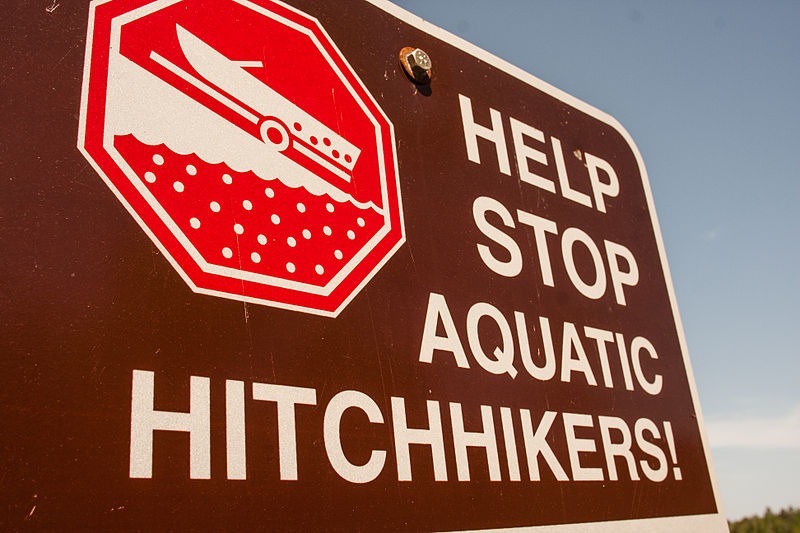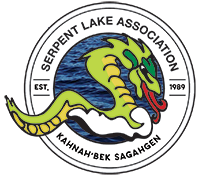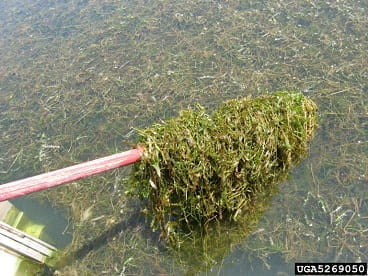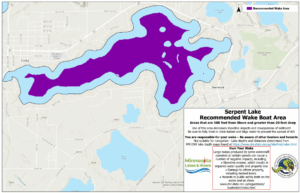Environmental
Help Stop Aquatic Hitchhikers – Prevent the Transport of Aquatic Invasive Species
Enjoying the great outdoors and Serpent lake is important to all of us – we want to preserve these traditions for our children and their children. Today these traditions are at great risk due to aquatic invaders that threaten our valuable waters and recreation. The main way invasive species get into lakes is by “hitching” rides with anglers, boaters and other recreationalists. We can all help protect our waters.
 Minnesota Law requires actions to clean all boats and recreational equipment.
Minnesota Law requires actions to clean all boats and recreational equipment.
INSPECT your boat, trailer and equipment and REMOVE visible aquatic plants, animals, and mud before leaving the water access.
DRAIN water from your boat, motor, bilge, live wells, and bait containers before leaving the water access. Leave drain plug out while trailering.
SPRAY, RINSE, or DRY boats and recreational equipment to remove or kill species that were not visible when leaving a waterbody. Before transporting to other waters:
- Spray/rinse with high pressure, and/or hot tap water (above 120 degrees), especially if moored for more than a day; or
- Dry for at least five days
DISPOSE of unwanted bait and other animals or aquatic plants in the trash. It is illegal to release live bait. When keeping live bait from infested waters you must replace water in bait containers with tap or spring water.
The DNR and state legislature has enacted policy and legislation changes that take effect spring 2012 to fight the spread of invasive species in Minnesota. These changes include increased inspections and stronger enforcement of the laws.
Thank you for your helping protecting our valuable lakes !
The Serpent Lake Association Board
SLA members told of growing problems of Curly Leaf Pondweed and water quality at annual meeting
The meeting was held on Saturday, June 25 at Salem Lutheran Church in Deerwood. The good attendance represented about one-third of the associations membership of 187.
President Wayne Brezina presented an overview of the association’s financial situation with a report on income and expenditures in the fiscal year just ending. The report, covering 11 months through May 30, showed that membership dues totaled $4,575, slightly more than budgeted. But donations to the Preservation Fund, used to pay for treatment of the invasive plant called Curly Leaf Pondweed, at $13,159, totaled less than half of the budgeted $28,562.
“We had a fund-raising challenge” in trying to reach the Preservation Fund’s goal in the current difficult economic environment, said President Brezina. Due to the shortfall, the association scaled back spending on Curly Leaf Pondweed treatment to $20,053, rather than the ambitious goal of $36,000 in the budget. Total expenditures of the association in the 11-month period were $24,583, much below the projected $42,680. The SLA ended the period with a bank balance of $6,017.49 as of May 30.
For the 2011-2012 fiscal year, the association is projecting dues income at $4,625 and donations to the Preservation Fund of $31,338. The budget again projects spending for treatment of Curly Leaf Pondweed at $36,000. President Brezina noted that to reach that goal for treatment of the invasive species would require an average donation of $140 from each of the SLA’s 185 projected members.
Board member Dennis Bowles presented a report on the spread of Curly Leaf Pondweed in Serpent Lake. “Curly Leaf Pondweed is alive and well in Serpent Lake,” he said, adding that “there are some huge beds out there.” He reported that 31 separate beds of the invasive plant have been found in the lake, including a new bed found last August off Minister’s Point.
The beds were marked last August and treatment was done on May 27 this year, Bowles said. A total of 50.5 acres was treated, but due to the shortfall of funds, the concentration of the treatment solution was reduced. It won’t be known until next year if the reduced concentration will make the treatment less effective. Bowles noted that, once in the lake, Curly Leaf Pondweed cannot be totally killed off without totally killing the lake–all plants, fish and living species. Treatment is intended to minimize the spread of the invasive plant.
- Boaters are urged to try to avoid motoring through the existing beds of Curly Leaf Pondweed to avoid spreading the invasive species to additional parts of Serpent Lake, and to clean off their boats and motors when taking boats out of the lake.
Past President Clark Marshall presented a report on a new two-year study of water quality and contamination sources of Serpent Lake, which will conclude in the spring of 2013. The main sponsor of the study, which will cost $86,394, is Crow Wing County. A Clean Water Partership grant of more than $43,000 from the Minnesota Water Pollution Agency is the primary funding for the study, with contributions in money and in-kind from several other sources including SLA.
“The quality of our water is going down,” Marshall remarked, explaining that the study seeks to quantify the quality deterioration and to identify sources of contaminants and pollution. Serpent Lake presents a particular challenge because of all the lakes in Crow Wing County, it has more impervious surface area–such as paved roads, parking lots, building roofs and the like–on its shores than any other lake in the county, Marshall said. This is primarily due to the presence of two cities, Crosby and Deerwood, immediately on its shoreline, one on each end.
During the two-year study, water quality samples will be taken from various locations on Serpent Lake twice a month during the months of May through September, Marshall said. SLA volunteers will assist in the collection, and members are urged to volunteer to help with this study. An engineering consulting firm will take the data that is gathered and create a computer model of the lake, which can be used to project outcomes for water quality based on projected changes of inputs. For example, the model could project what would happen to water quality if there were less (or more) inflow of phosphorus into the lake.
Based on various model outcomes, the firm can make recommendations on ways to improve lake water quality over time, Marshall said.
Also at the meeting, the membership elected a proposed slate of nominees to fill three-year terms on the SLA board for 2011 to 2014. Those elected are: Wayne Brezina, Ron Tudisco, Gary Stormoen, Glen Vanic and Deb Leonard. Gwen Stanich was elected to fill a one-year term ending in 2012. In addition, Bruce Butler agreed to stand for the remaining one year term and was also elected with the rest of the slate.
–Jim Gannon
Toss those big Northerns back in the lake to control the pike population
By Bob Hoeft
Here is a reminder to all fellow fisherfolk on Serpent Lake. Keep Northern Pike 24 inches or less, and return those between 24 and 36 inches to the lake. Why? Because this will help control the number of small Northern Pike in the lake.
The Northern Pike is at the absolute top of the food chain, and the only thing that will eat a Northern Pike is a larger Northern Pike. If we take all of the large Northern Pike out of the lake, there is an over-abundance of small ones that are stunted and feast on stocked walleyes and other forage fish.
In Serpent Lake this is only a voluntary guideline. Signs are posted at each of the public landings encouraging the practice of keeping only Northern Pike under 24 inches. In past years the Serpent Lake Association inquired about making this a mandatory rule, but the Department and the state legislature has moved away from this practice in spite of the fact that where it has been enacted and enforced the size of Northern Pike has increased significantly.
If you are wondering what to do with those smaller Northern Pike, learn how to fillet them removing all bones. There are many sites on the internet that graphically show you how. Just Google Northern Pike. They are good eating.
Volunteers needed to help study declining water quality in Serpent Lake
Background
In October the Minnesota Pollution Control Agency (MPCA) approved a proposal seeking funding through the Clean Water Partnership (CWP) to study the nutrient sources that are causing water quality problems in Serpent Lake. The awarding of this grant follows a 2009 determination by the MPCA that Serpent Lake water quality is in decline. The aim of the grant is to pinpoint the cause of the decline of Serpent Lake so useful action can be taken to reverse it.
The total project is expected to cost $86,000 and will be accomplished over two years beginning in 2011. The grant requires a 50% match so the MPCA is providing $43,000 of the funding and the participating local organizations will need to provide the remainder. The participating local organizations are the Serpent Lake Association, the City of Deerwood, the City of Crosby, Deerwood Township, and Irondale Township. Crow Wing County has an oversight responsibility. While there is some cash being contributed by the participants, the majority of the match will be achieved through in-kind contributions provided by the SLA volunteers. “In-kind” donations include volunteer labor hours (at $25 per), car mileage to meetings or to launching sites or to deliver samples, boat gas, boat time and the like.
Project Overview
The goal of this project is to determine the phosphorus and nutrient loads associated with the inflows and outflows of Serpent Lake. This will be accomplished by having volunteer teams, organized by the SLA, take multiple water samples during the 2011 and 2012 growing seasons from a number of locations. These locations include Cranberry, Peterson, Cascade and Serpent Lakes. Additional samples will be gathered from inflowing streams and the outlet at Serpent Creek. The volunteers will also gather lake bottom sediment. All samples will be analyzed at a state–certified laboratory. Following the data collection period a specialist will analyze the data and create what is called a “Bathtub” model of Serpent Lake and publish the findings.
Project Plan Summary
March 2011: Identify and organize volunteers
April 2011: Train the volunteers
May-September 2011 and 2012: Collect samples as required
IMMEDIATE NEED
- Please consider being a volunteer on this project. We need your help to earn the necessary hours to meet our in-kind match on this very important effort. We are Team Serpent Lake Water Collection: This team would collect one sample per month from multiple sites on Serpent Lake and deliver the samples for lab testing. This work is best done from a pontoon boat.
- Team 2- Cranberry, Peterson, and Cascade Lake Water Collection: This team would collect one sample per month from each of Cranberry, Cascade, and Peterson Lakes and deliver the samples for laboratory testing. This work would likely need a canoe.
- Team 3-Stream Collection: This team would collect 10 samples from each designated stream location in Serpent Lake on a scheduled basis throughout the growing season. Deliver samples for laboratory testing.
- Team 4-Rain Event Collection: This team would collect samples from designated stream locations in Serpent Lake whenever there is a rain event over 1 inch. Deliver samples for laboratory testing.
- Team 5-Sediment Collection: Assist the MPCA/Crow Wing Soil and Water staff once a month to gather sediment samples from Serpent Lake.
Please notify Clark Marshall cmarshall@charter.net by March 31 if you have an interest in being a volunteer for this project. This is a great opportunity for more of you to get involved with an important SLA project and learn more about our lake. Consider getting your Jr/Sr high school student involved. The SLA has had young people involved in this type of work for many years.
Reader Poll: Tell us your opinion. Do you think the water quality in Serpent Lake has been declining in recent years? Please vote in the poll in the column to the right of this article.
SLA – Supported proposal wins $42,744 state grant to assess contaminant sources for Serpent Lake
The Minnesota Pollution Control Agency has approved major grant funding for a two-year study of sources of pollution of Serpent Lake.
“I am pleased to notify you that, on October 8, 2010, MPCA Commissioner Paul Eger approved the funding for your Clean Water Partnership (CWP) proposal submitted in July, 2010. The MPCA, together with 6 other agencies/organizations, reviewed each proposal carefully to determine the projects for funding. Your project was one of seventeen chosen to be funded this year. The grant award for this project is $42,744.”
The purpose of this grant is to identify and assess contaminant sources of Serpent Lake over a two year period. It is supported by a number of local governmental units including the Serpent Lake Association. The full funding request was approved. This is a very significant grant as the involvement of the MPCA is needed for future SLA efforts to stem the decline in the water quality of Serpent Lake.
Laws on lakefront development a confused “mess,” lawmakers say: legislature may act next year
Laws and regulations governing development on Minnesota’s lakes have become so confused by contradictory court decisions that the legislature may have to try to rewrite them for clarity, key state lawmakers told the Star Tribune.
The Twin Cities newspaper reported in its Oct. 9 editions that court decisions have become so convoluted that laws may need to be fixed, said state Sens. Ellen Anderson, DFL-St. Paul, and Mary Olson, DFL-Bemidji. “I have to ask if we’re being fair to Minnesotans,” Olson said. “The court decisions are very lacking in uniformity.”
The article said court decisions have added confusion to an area of the law that already is subject to widespread discrepancies in local governmental interpretation and is subject to heavy political pressures from property owners and real estate interests. Last July, the Star Tribune published a series of articles examining widespread deviations from development rules in Crow Wing and Cass counties due to heavy use of variances from the regulations.
Curly-leaf pondweed: A menace spreads in Serpent Lake
By Clark Marshall and Bob HoeftWhile this summer’s news was dominated by the calamitous oil spill in the Gulf of Mexico, here, closer to home, we have our own spreading menace to Serpent Lake: Curly-leaf pondweed.
It seems that mother nature has been arduously working against our efforts to stem the spread of this invasive non-native plant species. CLPW grows under the ice. It thrives in cool water. It dies back when summer water temps exceed 70 degrees.
- A mat of curly leaf pondweed found in Serpent Lake CLPW growth and reproduction has been greatly stimulated in the past year with light snow cover on the ice, cool 2009 summer water temperatures and early ice-out dates. This is a problem for those who enjoy the use of Serpent Lake. Weed mats interfere with boating and native plant species are displaced. Most troublesome, the water quality of Serpent continues to decline (1.5 feet of clarity is lost every 10 years) in part because of the nutrients introduced when the new crop of CLPW dies in the summer.
The Serpent Lake Association has raised the needed funds and established treatment programs with the Minnesota Department of Natural Resouces and Professional Lake Management Corp. for the past five years. The results have been largely successful in beds where CLPW has been treated. Weed mats have been eliminated and CLPW biomass has been significantly reduced.
This non-native plant, however, can never be eradicated from the lake–it can only be controlled. CLPW reproduces effectively by spreading turions (small seed pods) that disperse and can lay on the lake bottom for several years before sprouting into new plants. Treatments kill off the growing plants and allow native plants to repopulate the weed beds. However, the treatments do not kill the turions.
Because the turions can disperse, new curly leaf pondweed growth often emerges outside of known beds or in completely new areas. Areas of an acre or more seem to suddenly emerge, creating a mat of weeds on the surface of the water, unlike any other vegetation in Serpent Lake.
- The long leaves have serrated edges.
So you will know it when you see it: look for long stems of elongated small leaves with a serrated edge. Several new beds were identified in Serpent Lake this spring after treatments were completed. The variable nature of CLPW growth patterns creates planning and fund raising problems for the Serpent Lake Association.
In fact, the Association did not have enough funds to treat all areas that needed treatment this spring. At $344 per acre, 34 acres were treated in 2010. That comes to an eye-catching $11,969, almost double what was spent last year.
Even so, more than twice that acreage should have had treatment. This explosion in CLPW growth was not anticipated. Clearly, the Serpent Lake Association will need to revisit its treatment policies and institute a mechanism for prioritizing weed beds when all of them cannot be treated. We will also need to raise significantly more funds. The Serpent Lake Association has budgeted over $36,000 for CLPW treatments in 2011 given the spreading reality of CLPW.
Often people will say, “It is the Minnesota Department of Natural Resource’s responsibility to take care of this.” Make no mistake; the Minnesota DNR has been an important partner in establishing treatment, but only as an advisory and permit granting agency. The leadership and fundraising is all volunteer and local and it is provided by the Serpent Lake Association.
Past contributions have almost exclusively come from lake residents and local businesses rather than units of government, though it should be noted the City of Deerwood has been a contributor. An attempt by the Serpent Lake Association to establish a Lake Improvement District for taxation of residents of Serpent Lake was defeated by the Crow Wing County Board twice, although this has been an accepted method of raising funds for controlling non-native species within this county and the state.
Literally hundreds of hours of volunteer time and thousands of dollars are given by members of the Serpent Lake Association to control CLPW. This organization and its leadership remain committed to protecting the valuable public resource that Serpent Lake represents to our community. It is hoped that the public, businesses, and local governmental bodies will increasingly join in this effort to protect and improve the magnificent asset called Serpent Lake.
Tightened lakeshore development rules now treading water after Gov. Pawlenty’s disapproval
New rules meant to limit dock sizes and protect Minnesota lakeshore from overdevelopment and environmental threats have been sent back to the drawing board following Governor Tim Pawlenty’s mid-August rejection of the years-long effort.
The governor rejected two sets of rules drafted by the Department of Natural Resources that have been in the making since 2007. Calling the proposed rules “overreach,” Pawlenty said the revisions “unfairly undermine important property rights” and override local control of development.
The proposed DNR regulations were strongly supported by many environmental and conservation organizations and some lake associations, but they were opposed by some lakeshore property owners, builders and developers on grounds that they unfairly restricted rights to private property.
The Minnesota legislature in 2007 directed the DNR to update the state lakeshore development regulations, which were last revised 21 years ago. A boom in lakeshore property development in the last two decades resulted in the building of many large lake homes with massive roofs, fertilized lawns, concrete driveways and other features that result in heavy runoff of polluted water into the lakes, which degrades water quality and promotes unwanted acquatic growth.
Department of Natural Resources Commissioner Mark Holsten said many citizens and stakeholders have expressed concerns similar to the governor’s, and his agency will go back to work, the Associated Press .
“The rules you forwarded to me regarding these issues do not strike a proper balance between protection of our lakes and waterways and the equally important right of our citizens to enjoy them and their property,” Pawlenty said in a letter to Holsten.
The rejected rules would have increased minimum setbacks for new homes and developments along lakeshores. They would have restricted the amount of pavements and hard surfaces to reduce runoff, and would have required new or updated septic systems for homes and cabins when they change ownership. They also would have tightened restrictions on the size of docks and required new builders to plant natural vegetation near lakeshores to inhibit runoff of chemicals that would promote algae growth in lakes or pollute lake water.
Trolling for trash: beer cans, an old tire, rusty fire pit and more emerge from the lake
By Bob and Barbara HoeftIt was a nice Sunday afternoon in May, with not a ripple on the water. Over Sunday dinner we talked about what we would do to enjoy the afternoon. Then, an idea struck like a thunderbolt from heaven: we would see how much debris we could pick up from the bottom of the lake in an hour or two.
Armed with a metal rake, landing net and a pitchfork we set out in our boat to see what treasures we could find. It only took a few moments before we spotted our first beer can. After some maneuvering we managed to reach over the side and get it into the net. Wow! Success already. Soon we had several cans.
- Barb Hoeft and grandson Quentin Tschofen with some of the trash haul.
Then we spotted a real challenge, the first of several: an automobile tire sunk into the muck. Reaching down with the rake, it took the work of two people to haul it into the boat, spilling its muddy contents in the process. That was more than we counted on.
Being intrepid seekers of trash we continued on, soon discovering a yellow and white plastic leech container mired in the muck. With no idea how long it had been there, we finally dislodged it only to find that it was full of dead leeches. Lucky us! Cleaned up, it’s quite usable. If it’s yours, give us a call.
Then came another test for our skills: a metal fire ring possibly used on the ice and left to sink as the ice melted. It had hazardous jagged edges and we carefully balanced it on top of the tire on the bow of the boat. We were unmistakably trash haulers.
Other odd items retrieved included a full can of pop, an oil can, a children’s duplo block, food wrappers, plastic bags and an assortment of beer and pop cans. Golf balls escaped through our net.
The next time out we will be leaving recovered tires on the nearest dock. That was the one thing the garbage haulers did not take and will require a special trip to the landfill. Three beer cans were found in front of one dock and we were tempted to leave them there as a surprise. We did not do it, but you know who you are.
Who knows what kind of trash lies beyond the depths we were able to reach with our crude equipment? Next year we hope to survey the same area again, equipment in hand and weather permitting. Maybe others would like to give this a try too; better yet, the debris should not be in the lake in the first place.


